Young people's participation in decision making in Scotland: attitudes and perceptions
Findings from a survey of secondary school pupils on perception of their ability to influence decisions that affect them.
2. Views Towards Adults in General
The first set of question asked about young people's perceptions of adults in general, including family, teachers, youth workers, sport coaches and Scouts/Guides leaders.
Adults listening to young people
Pupils were asked to what extent they agreed or disagreed that adults in general, such as their family, teachers, youth workers, sport coaches and Scouts/Guides leaders, are good at listening to their views.
As Figure 2.1 shows, almost six in ten (58 per cent) respondents agreed that adults were good at listening to their views (20% strongly agree, while 37% tended to agree). However, two in ten disagreed that adults were good at listening to them (8 per cent strongly disagreed, 13 per cent tended to disagree).
Figure 2.1 Agreement with statement 'Generally, adults are good at listening to my views'
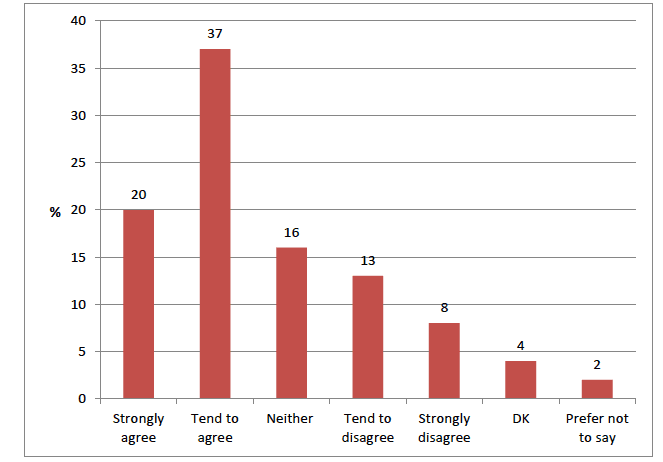
Base: 1781
As Figure 2.2 shows, boys were more positive than girls, with 62 per cent of boys agreeing to the statement compared to 55 per cent of girls.
Figure 2.2 Agreement with statement 'Generally, adults are good at listening to my views', by gender
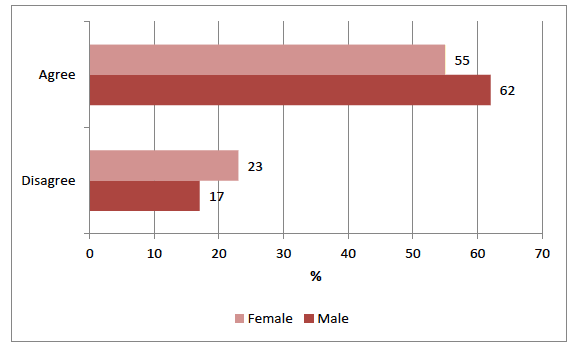
Base: 1715
As Figure 2.3 shows, the percentage agreeing that adults are good at listening decreased consistently between S1 and S5. In S1, 79 per cent of pupils agreed that adults are good at listening to their views, while in S5, 45 per cent agreed. However, in S6 perceptions were more positive with 56 per cent of pupils agreeing that adults are good at listening to their views.
Figure 2.3 Agreement with statement 'Generally, adults are good at listening to my views', by school year
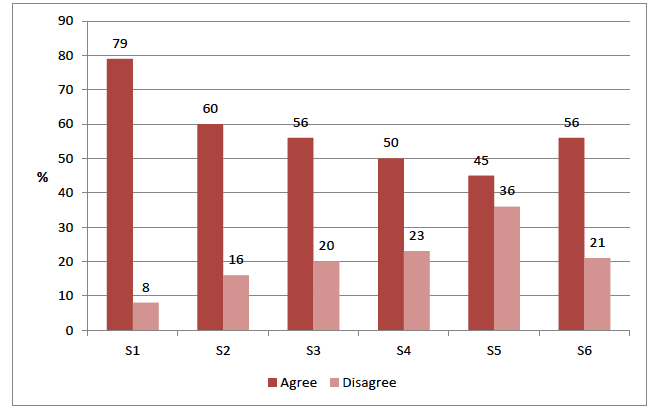
Base: 1755
Pupils with physical or mental health conditions were much less likely to feel listened. 29 per cent disagreed that adults are good at listening to their views, almost twice as many as among those with no health condition (17 per cent).
As Figure 2.4 shows, patterns by Scottish Index of Multiple Deprivation ( SIMD) [2] did not show a clear directional pattern. Those in both the most and least deprived areas were more likely to agree that adults listen to their views (61 and 64 per cent respectively) than those in the middle quintiles (54 to 55 per cent).
Figure 2.4 Agreement with statement 'Generally, adults are good at listening to my views', by area deprivation
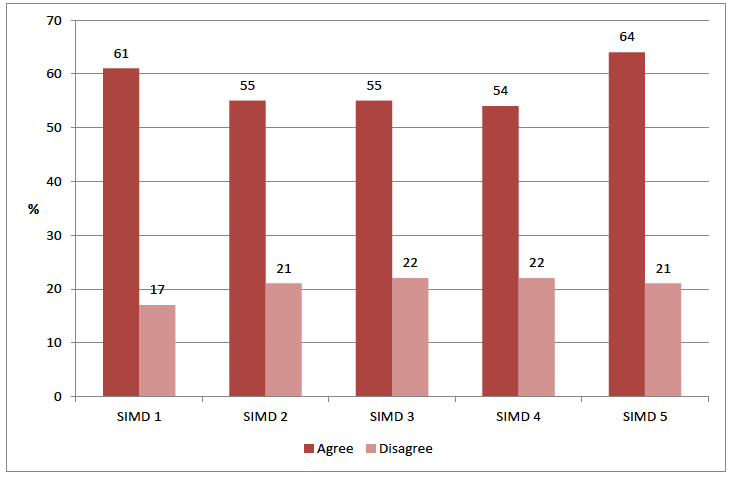
Base: 1781
Adults taking young people's views into account
Pupils were asked to what extent they agreed or disagreed that adults in general, such as their family, teachers, youth workers, sport coaches or scouts/Guides leaders, are good at taking their views into account when making decisions that affect them. This question was intended to gauge whether young people feel that adults take action after listening to their views.
As Figure 2.5 shows, just over half (53 per cent) of pupils agreed that adults take their views into account when making decisions (including 18 per cent strongly agreed). Just under two in ten disagreed (including 8 percent who strongly disagreed).
Figure 2.5 Agreement with statement 'Generally, adults are good at taking my views into account when making decisions that affect me'
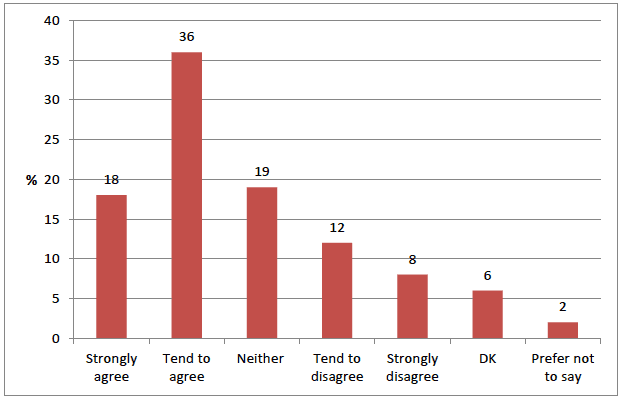
Base: 1781
As Figure 2.6 shows, boys were more positive than girls: among boys, 58 per cent agreed and 15 per cent disagreed that adults took their views into account when making decisions, compared to 51 per cent and 22 per cent among girls.
Figure 2.6 Agreement with statement 'Generally, adults are good at taking my views into account when making decisions that affect me', by gender
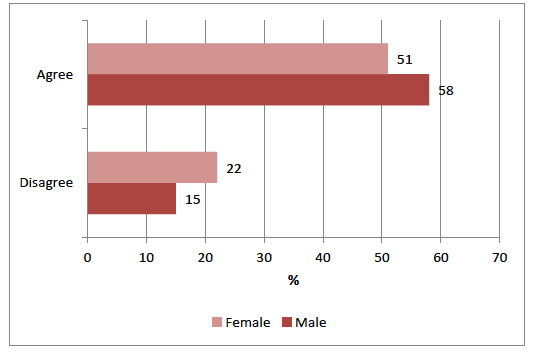
Base: 1715
As Figure 2.7 shows, perceptions were most positive in S1 (72 per cent of pupils agreed that adults take their decisions into account) and became progressively more negative up to S5 (42 per cent agreed), but then recovered slightly at S6 (51 per cent agreed).
Figure 2.7 Agreement with statement 'Generally, adults are good at taking my views into account when making decisions that affect me', by school year
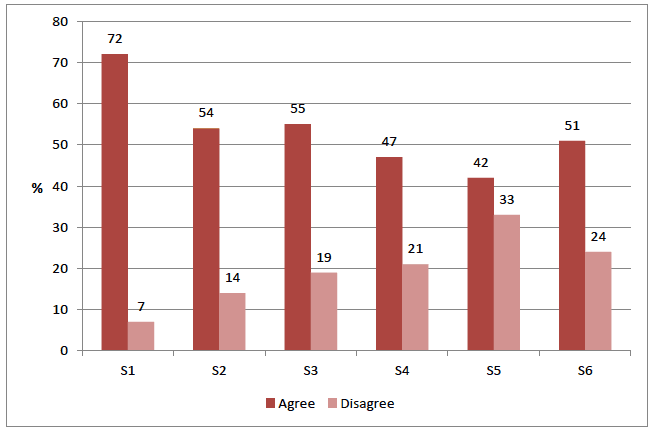
Base: 1755
Pupils with a physical or mental health condition were substantially less positive. Those with a health condition were twice as likely to disagree that their views are taken into account, than those without a health condition (30 per cent, compared with 15 per cent).
Barriers to listening
Survey respondents were asked what, if anything they thought stopped adults from listening to their views.
As Figure 2.8 shows, over two thirds of young people gave at least one barrier that stopped adults from listening to them from a pre-coded list. Just 14 per cent said that there were no barriers, and the same percentage said they didn't know.
The most commonly selected answer was 'it doesn't fit with what they want to hear' (38 per cent); followed by 'they don't like their views being challenged' (33 per cent); 'they don't have time to listen' (30 per cent) ;and 'they don't think my views are important' (28 per cent).
Figure 2.8 Barriers to adults listening to young people
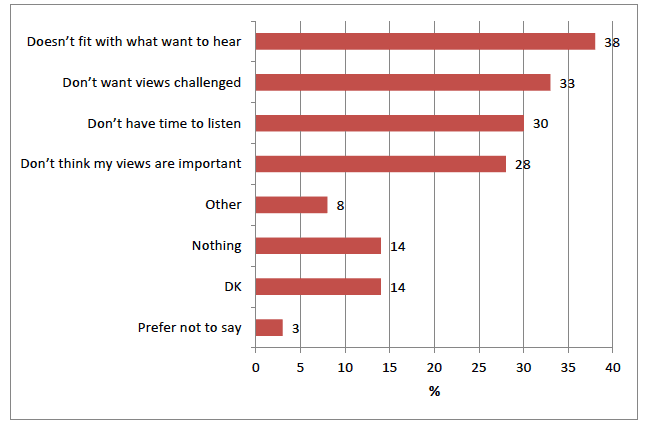
Base: 1781
As Figure 2.9 shows, girls were more likely to select each of the barriers (including other) than boys. However, there was no statistically significant gender difference in the percentage of respondents saying that there there were no barriers.
Figure 2.9 Barriers to adults listening to young people, by gender
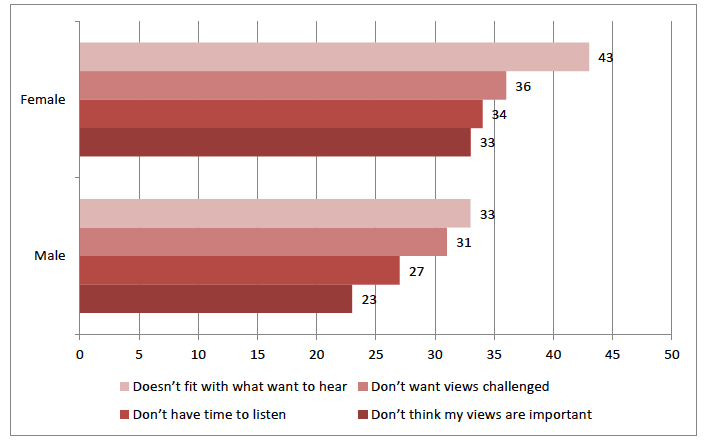
Base: 1715
As Figure 2.10 shows, the percentage selecting most of the barriers increased consistently with school years. For example, S6 pupils were more than twice as likely (52 per cent) to give 'it doesn't fit with what they want to hear' as a reason for adults not listening to them than S1 pupils (24 per cent). The only exception to this pattern was the statement 'they don't have time to listen', which was selected by around three in ten pupils in all school years.
Figure 2.10 Barriers to adults listening to young people, by school year
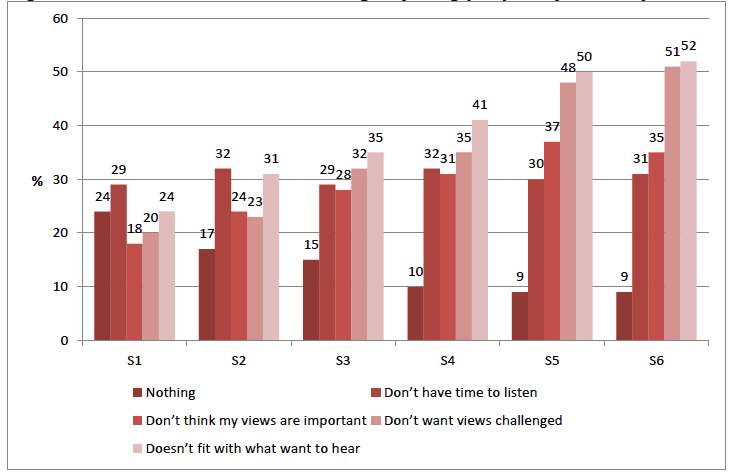
Base: 1755
Young people with a physical or mental health condition were more likely to select all options, particularly 'they don't think my views are important', which was selected by 37 per cent, compared to 26 per cent among those without a health condition.
Barriers to taking young people's views into account
Respondents were then asked what they saw as the barriers to adults taking their views into account when making decisions. As Figure 2.11 shows, the most commonly selected statement was 'they don't like their views being challenged ' (30 per cent); followed by 'they don't have the power to make any changes' (26 per cent); 'they don't think that my views are important' (also 26 per cent) and 'they don't want to put in the work to make any changes' (21 per cent). The percentage saying they didn't know was high at 20 per cent.
Again, girls were more likely than boys select each statement, and were also less likely to say that there were no barriers or that they didn't know. Figure 2.12 presents these findings.
Figure 2.11 Barriers to adults taking young people's views into account when making decisions
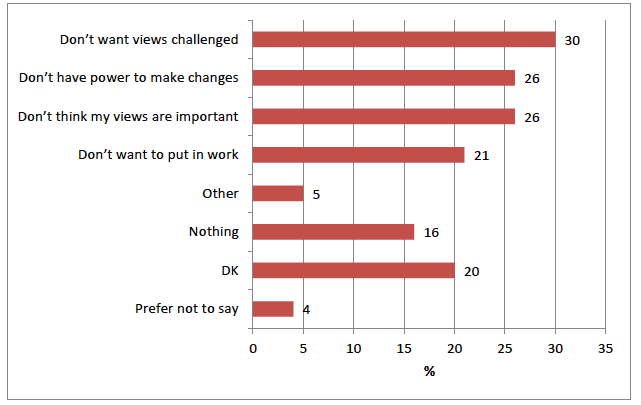
Base: 1781
Figure 2.12 Barriers to adults taking young people's views into account when making decisions, by gender
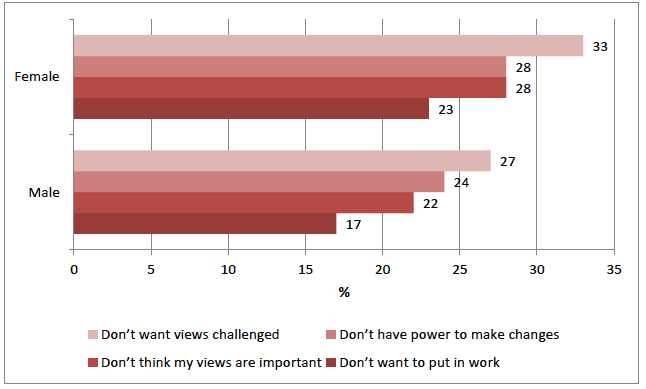
Base: 1715
As Figure 2.13 shows, the percentage selecting each option broadly increased with school year, although not quite as consistently as for the previous question. The gap between S1 and S6 views was very wide: Pupils in S1 were nearly four times as likely to say that there were no barriers (31 per cent compared to 8 per cent in S6), and more three times as likely to feel that adults don't like their views being challenged (16 per cent compared to 53 per cent).
Figure 2.13 Barriers to adults taking young people's views into account when making decisions, by school year
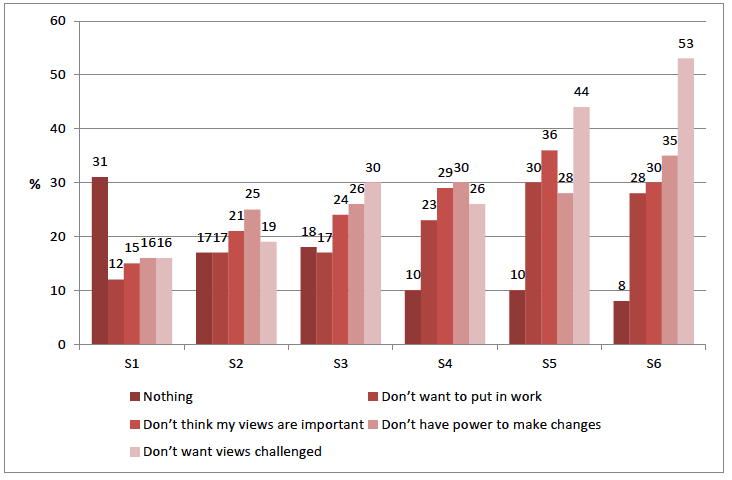
Base: 1755
Pupils with a physical or mental health condition were more likely to select all options, in particular 'they don't want to put in the work to make any changes' (30 per cent compared to 19 per cent of those without a health condition) and 'they don't think my views are important' (30 per cent compared to 24 per cent of those without a health condition).
Contact
There is a problem
Thanks for your feedback